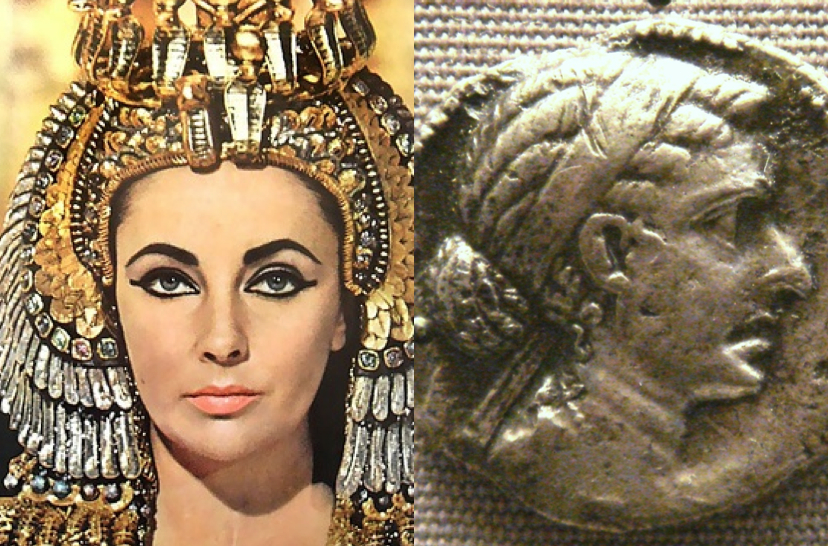There are two prevailing beliefs about Cleopatra. The first is that she was a captivating beauty, so dazzling that she was able to snare two of the world’s most powerful men. The second is that she was an ugly, hook-nosed hag.
So which is the truth?
Despite, or perhaps because of, the iconic portrayals of the Queen of the Nile as a ravishing seductress, Cleopatra’s detractors point to the coins that were issued during her reign as evidence of her hideous appearance. Few of the coins issued during her reign are remotely flattering. But it must be noted that coins were stylized and meant to project an intimidating appearance. Mark Antony was said to be quite handsome and Augustus was described as a young Apollo and yet, they don’t always fare very well on all their coins either.
A more accurate way to gauge Cleopatra’s beauty is to check out her marble busts, which were carved in a time of Roman dominance where realism trumped Hellenistic idealism in artistic renderings. The marble busts of Cleopatra do not reveal a ravishing beauty, but neither do they portray a hook-nosed hag. What we see is a reasonably attractive woman in white marble without the color of a blush upon her cheek.
What about the literary evidence? Ancient historian Cassius Dio recounts that Cleopatra was “a woman of surpassing beauty,” and Plutarch tells us that Cleopatra was “a woman who was haughty and astonishingly proud in the matter of beauty.” However, a passage from Plutarch is often latched onto as evidence that the queen was anything but. In Plutarch’s Life of Antony, he writes,
“For her beauty, as we are told, was in itself not altogether incomparable, nor such as to strike those who saw her; but converse with her had an irresistible charm, and her presence, combined with the persuasiveness of her discourse and the character which was somehow diffused about her behaviour towards others, had something stimulating about it. There was sweetness also in the tones of her voice; and her tongue, like an instrument of many strings, she could readily turn to whatever language she pleased…”
This passage is often taken to support the argument that Cleopatra had the face of a troll, but it seems to me that Plutarch is giving us an honest assessment. Her beauty may not have been incomparable, but she did have some.


So there’s hope for those of us who are somewhat less than ravishing!! Woo hoo!
It’s funny how popular perception of Cleopatra has swung from her being a gorgeous temptress a la Liz Taylor, to an ugly smart woman. (A bit sexist, no?) Like you, I’ve looked at a lot of contemporary depictions of her and the marble busts are probably the most accurate representations.
A bit sexist, yes! Maybe more than a bit. It seems as if with women, it must always be an extreme.
We have a major problem with anorexia and bulimia throughout the whole world, and both conditions be fatal. In our culture (here in the U.S.A.) we put too much value on personal appearance and too little on whether that person is a kind and decent human being. What the heck does it matter whether Cleopatra was ugly or beautiful. It shouldn’t matter at all! The fact that we judge someone by how beautiful or handsome she or he is doesn’t say much good about our country–does it.
When more than two thirds of our population is overweight or obese, I wouldn’t say anorexia is the most pressing of problems. And physical appearance is an important part of who we are, for better or worse.
Those of us who study history do want to know what ancient persons looked like, just as we want to know there character and life histories.
well said! you took the words right out of my mouth! William S. Bachman was obviously curious about cleopatra’s looks too or he wouldn’t be here.
I really don’t believe in a “ugly Cleopatra”… I think she was a charming woman who didn’t have the classic beauty of her time, but nonetheless, can be considered an ugly woman. If we analyze the most striking features in her marble busts, we see that she had a sharp nose and a large mouth which was wide open in a stunning and captivating smile, traits that can be seen on Julia Roberts, for example…
So, I see Cleopatra as a very charming woman with an exotic beauty, and rightfully so, that might not be appreciated by all.
Thank you for these thoughts!
Nice… heart touching…. But I like to know the real intention of her noseless statue. If someone mailed me, that wouls be very nice.
I beleive Cleopatra wasn’t a stunning person she was just normal looking for her time but it was her presance and personality that made her who she was it said that she had a beautiful voice and was very persuasive too, it also says that people wanted to listen to her. so yeah she might of been pretty for that time but they have a diferent less biased defiantion of beautiful our socity is so twisted with what it thinks is beautiful it has caused so much sadness and obsession over what is beautiful but we need to start thinking about the persons personalitiy instead of how pretty they are. She probably wouldn’t be beautiful by our societys standards but it was how she carried herself and her personality that made her who she was.
Everyone tells me Cleopatra was really hideous! But ive always thought she would have been very attractive? im still confused